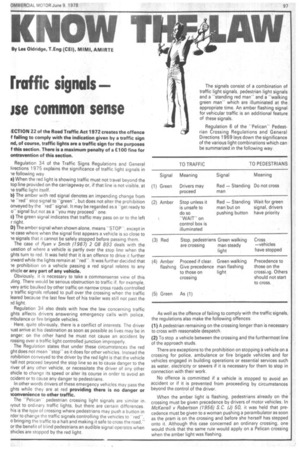Traffic signals.
Page 99

If you've noticed an error in this article please click here to report it so we can fix it.
ine common sense
;ECTION 22 of the Road Traffic Act 1972 creates the offence f failing to comply with the indication given by a traffic sign nd, of course, traffic lights are a traffic sign for the purposes f this section. There is a maximum penalty of a £100 fine for ontravention of this section.
Regulation 34 of the Traffic Signs Regulations and General irections 1975 explains the significance of traffic light signals in le following way.
El) When the red light is showing traffic must not travel beyond the top line provided on the carriageway or, if that line is not visible, at le traffic light itself.
b) The amber with red signal denotes an impending change from le "red" stop signal to "green'', but does not alter the prohibition onveyed by the "red" signal. It may be regarded as a "get ready to o" signal but not as a "you may proceed" one.
C) The green signal indicates that traffic may pass on or to the left r right.
D) The amber signal when shown alone, means -STOP'', except in le case where when the signal first appears a vehicle is so close to le signals that it cannot be safely stopped before passing them.
The case of Ryan v Smith (1967) 2 08 893 deals with the uestion of where a vehicle is partly over the stop line when the ghts turn to red. It was held that it is an offence to drive it further )rward while the lights remain at "red". It was further decided that le prohibition on a vehicle passing a red signal relates to any ehicle or any part of any vehicle.
Obviously, it is necessary to take a commonsense view of this _ding. There would be serious obstruction to traffic if, for example, very artic baulked by other traffic on narrow cross roads controlled y traffic signals refused to pull over the crossing when the traffic leered because the last few feet of his trailer was still not past the light.
Regulation 34 also deals with how the law concerning traffic ghts affects drivers answering emergency calls with police, mbulance or fire brigade vehicles.
Here, quite obviously, there is a conflict of interests. The driver lust arrive at his destination as soon as possible as lives may be in anger; on the other hand he must not cause an accident by rossing over a traffic light controlled junction improperly.
The Regulation states that under these circumstances the red ght does not mean "stop" as it does for other vehicles. Instead the rohibition conveyed to the driver by the red light is that the vehicle naIl not proceed beyond the stop line so as to cause danger to the river of any other vehicle, or necessitate the driver of any other ehicle to change its speed or alter its course in order to avoid an ccident or to cause any danger to pedestrians.
In other words drivers of .these emergency vehicles may pass the ghts while they are at red providing there is no danger or tconvenience to other traffic.
The "Pelican' pedestrian crossing light signals are similar in. iyout to ordinary traffic lights, but there, are certain differences. his is the type of crossing where pedestrians may push a button in rder to change the traffic signals controlling the vehicles to ''red", o bringing the traffic to a halt and making it safe to cross the road,or the benefit of blind pedestrians an audible signal operates when ehicies are stopped by the red light.
As well as the offence of failing to comply with the traffic signals, the regulations also make the following offences (1) A pedestrian remaining on the crossing longer than is necessary to cross with reasonable despatch.
(2) To stop a vehicle between the crossing and the furthermost line of the approach studs.
There are exceptions to the prohibition on stopping a vehicle on a crossing for police, ambulance or fire brigade vehicles and for vehicles engaged in building operations or essential services such as water, electricity or sewers if it is necessary for them to stop in connection with their work.
No offence is committed if a vehicle is stopped to avoid an accident or if it is prevented from proceeding by circumstances beyond the control of the driver.
When the amber light is flashing, pedestrians already on the crossing must be given precedence by drivers of motor vehicles. In McKerrell v Robertson (1956) S.C. (J) 50, it was held that precedence must be given to a woman pushing a perambulator as soon as the pram is on the crossing and before she herself has stepped onto it. Although this case concerned an ordinary crossing, one would think that the same rule would apply on a Pelican crossing when the amber light was flashing.




















































































































































